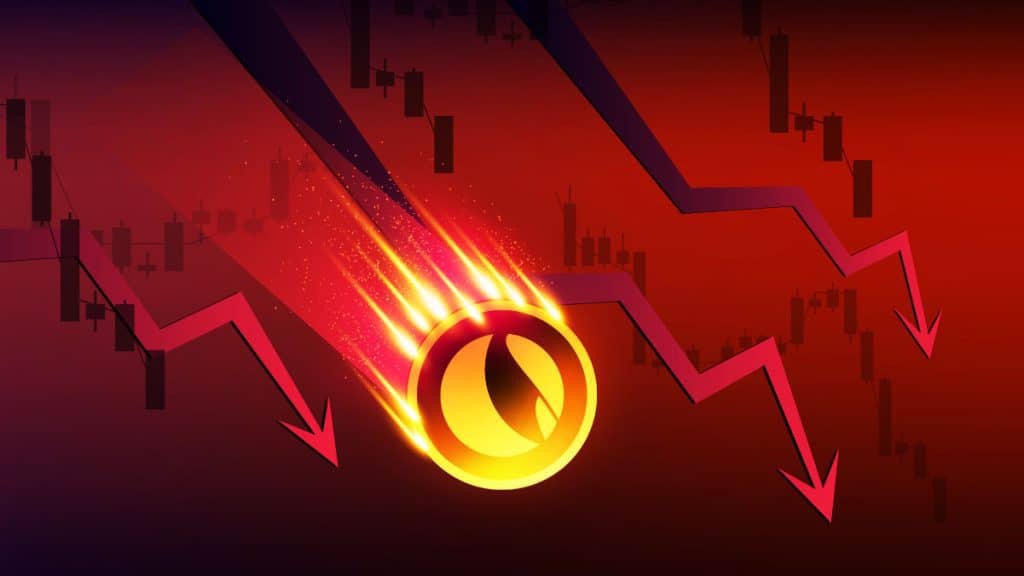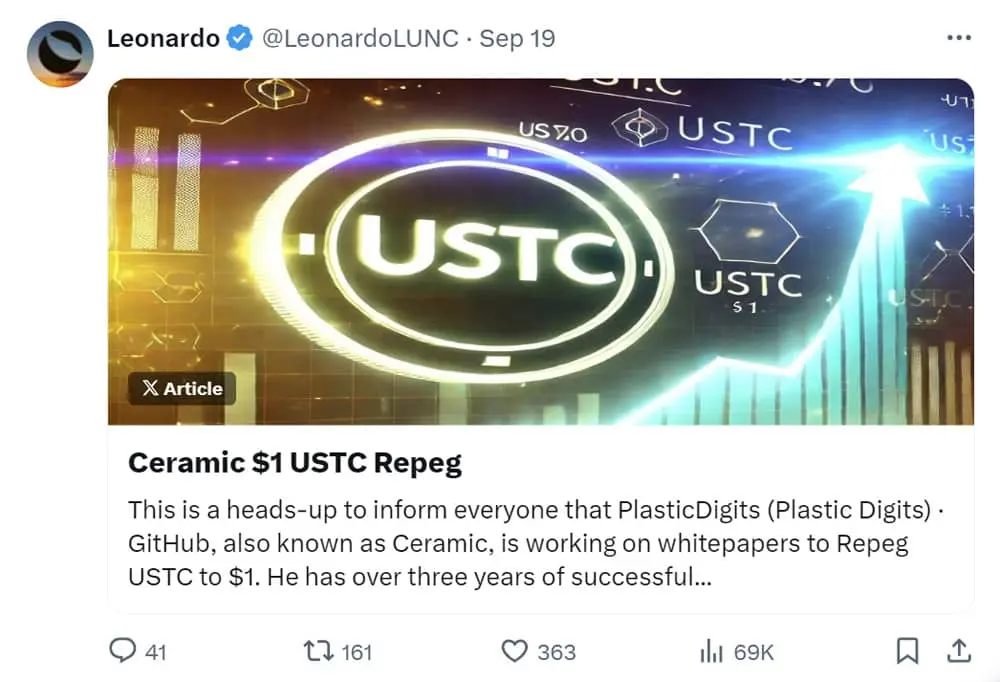Terra Classic (LUNC) is a cryptocurrency that emerged from the remnants of the Terra ecosystem following the collapse of the algorithmic stablecoin TerraUSD (UST) in May 2022. The collapse triggered a chain reaction, leading to the de-pegging of LUNA, the native token of the Terra blockchain. In response, the Terra community forked the blockchain, creating a new chain known as Terra 2.0 and leaving the original chain as Terra Classic.
LUNC serves as the native token of the Terra Classic blockchain, offering various functionalities such as governance, staking, and payment processing. Despite the challenges faced by Terra Classic following the collapse, the community remains committed to its development and restoration.
Terra Classic (LUNC) emerged from the tumultuous events that unfolded within the Terra ecosystem in May 2022. To understand LUNC's history, it's essential to delve into the origins of Terra and the subsequent market crash that led to its creation.

Founded in January 2018 by Do Kwon, Terra was a blockchain platform designed to create price-stable cryptocurrencies pegged to fiat currencies. The core concept was to provide a more stable alternative to traditional cryptocurrencies like Bitcoin, which can experience significant price fluctuations.
The native token of the Terra blockchain was LUNA. LUNA played a crucial role in the Terra ecosystem, serving as both a governance token and a reserve asset for maintaining the stability of Terra's stablecoins, such as TerraUSD (UST).

In May 2022, a series of events triggered a catastrophic collapse of the Terra ecosystem. TerraUSD (UST), a stablecoin pegged to the US dollar, began to lose its peg. As investors lost confidence in UST's stability, they started selling it, leading to a massive sell-off of both UST and LUNA.
The sell-off of LUNA caused its price to plummet dramatically. The collapse of UST and LUNA had far-reaching consequences, impacting the broader cryptocurrency market and causing significant financial losses for many investors.
In response to the crisis, the Terra community decided to fork the Terra blockchain. This meant creating a new version of the blockchain with different rules and parameters. The new chain became known as Terra 2.0, while the original chain was renamed Terra Classic.
The creation of Terra Classic preserved the original Terra blockchain and its history. LUNC, the native token of the original Terra blockchain, continued to exist on Terra Classic. However, the Terra Classic ecosystem faced significant challenges following the fork, including a loss of trust and a decline in its market value.
Terra Classic (LUNC) is a cryptocurrency with unique features and mechanics that set it apart from other digital assets. Understanding these features is essential to grasping the role LUNC plays within the Terra Classic ecosystem.
One of the key features of LUNC is its role as governance token. This means that LUNC holders have a say in the direction and development of the Terra Classic blockchain. By holding LUNC, individuals can participate in governance processes, such as voting on proposals and influencing decision-making.
This decentralized governance model empowers the community to shape the future of Terra Classic, ensuring that the project aligns with the interests and needs of its users.
LUNC serves as the foundation of the Terra Classic ecosystem. It is used for various purposes, including:
While LUNC shares similarities with the forked LUNA 2.0 token, there are some key differences:
LUNC is a multifaceted cryptocurrency with a governance token function and a central role in the Terra Classic ecosystem. Understanding these features is crucial for anyone interested in investing in or using LUNC.
To understand LUNC's technical foundation, it's essential to delve into the underlying blockchain technology, consensus mechanism, and smart contract capabilities.
Terra Classic, the blockchain network on which LUNC operates, is built on a Tendermint-based consensus mechanism. Tendermint is a Byzantine Fault Tolerant (BFT) algorithm designed to ensure the security and reliability of blockchain networks. It enables the network to reach consensus on the state of the blockchain despite the presence of malicious actors.
The Tendermint consensus mechanism used by Terra Classic works by having validators propose blocks to the network. These blocks contain transaction data. The validators then vote on whether to accept or reject the proposed block. Once a block receives a majority vote, it is added to the blockchain. This process helps to prevent attacks and maintain the integrity of the network.
Terra Classic supports smart contracts, which are self-executing contracts with terms directly written into code. These contracts are stored on the blockchain and automatically execute when predefined conditions are met. Smart contracts enable the creation of decentralized applications (dApps) on the Terra Classic network, such as decentralized exchanges, lending platforms, and gaming platforms.
LUNC is built on a solid technical foundation, utilizing a Tendermint-based consensus mechanism and supporting smart contracts. This technical infrastructure provides the necessary framework for the development of decentralized applications and the security of the Terra Classic network.
The Terra Classic community plays a vital role in shaping the development and direction of the LUNC ecosystem. Through a decentralized governance model, LUNC holders can actively participate in decision-making processes and influence the future of the project.
Terra Classic is a community-driven project, meaning that the community plays a significant role in its development. The community contributes to the project in various ways, including:
The governance model of Terra Classic is based on a decentralized system where LUNC holders have voting rights. The voting power of each LUNC holder is proportional to the amount of LUNC they hold. This ensures that the interests of the community are represented in decision-making processes.
Decisions on the Terra Classic network are made through a voting process. Proposals are submitted to the community, and LUNC holders can vote on whether to approve or reject them. The outcome of the vote determines whether the proposal will be implemented.
In addition to voting, the Terra Classic community also utilizes forums and social media to discuss and debate important issues related to the project. These discussions help to shape the consensus within the community and inform decision-making.
The Terra Classic community plays a crucial role in the governance and development of the LUNC ecosystem. Through a decentralized governance model, LUNC holders can actively participate in decision-making processes and shape the future of the project.
Understanding the economics of LUNC is essential to comprehending its value and potential future. This section will delve into the tokenomics of LUNC, the supply and demand dynamics, and the burning mechanism.
LUNC is a cryptocurrency with a total supply of 6.7 Trillion. This means that there is a finite number of LUNC tokens in existence. The supply of LUNC is not subject to inflation, which can be a positive factor for its long-term value.
Furthermore, LUNC is a deflationary token due to the burning mechanism implemented by the Terra Classic community. This mechanism reduces the circulating supply of LUNC, which can potentially increase its value over time.
The value of LUNC is determined by the interplay of supply and demand. When demand for LUNC increases relative to its supply, the price tends to rise. Conversely, when supply exceeds demand, the price may decline.
Several factors can influence the demand for LUNC, including:
The burning mechanism is a key feature of LUNC's tokenomics. This mechanism involves permanently removing LUNC tokens from circulation. By reducing the supply of LUNC, the burning mechanism can potentially increase its value.
Terra Classic community has implemented various burning mechanisms, such as transaction fees and community-driven initiatives. The effectiveness of these mechanisms in reducing the circulating supply of LUNC will play a crucial role in its long-term value.
The economics of LUNC are influenced by its tokenomics, supply and demand dynamics, and the burning mechanism. Understanding these factors is essential for investors and users of LUNC to make informed decisions.
LUNC, the native token of the Terra Classic blockchain, offers a variety of use cases that make it a versatile asset within the cryptocurrency ecosystem. This section will explore some of the primary applications of LUNC.
One of the fundamental use cases of LUNC is for payments and transactions. LUNC can be used to send and receive value between individuals or businesses. This provides a decentralized and potentially more efficient alternative to traditional payment methods.
Terra Classic also supports the development of decentralized applications (dApps) that can leverage LUNC for various payment-related services, such as online marketplaces, gaming platforms, and subscription services.
LUNC plays a crucial role in the development of decentralized finance (DeFi) on the Terra Classic blockchain. DeFi applications built on the network can utilize LUNC for various purposes, including:
Terra Classic features a CW20 tokens factory, which allows developers to create their own custom tokens on the network. These tokens can be used for various purposes, such as representing assets, memberships, or loyalty programs. LUNC is often used as a base token for creating CW20 tokens.
Dig deeper: List of top CW20 tokens.
In addition to the use cases mentioned above, LUNC has potential applications in other areas, such as:
As the Terra Classic ecosystem continues to evolve, new and innovative use cases for LUNC may emerge. The versatility of LUNC and the potential of the Terra Classic blockchain make it a promising asset with various potential applications.
The Terra Classic ecosystem has faced significant challenges and controversies since the collapse of TerraUSD (UST) in May 2022. These challenges have impacted LUNC's value and the overall development of the project.
The collapse of Terra had a devastating impact on the Terra Classic ecosystem. The loss of trust in the project and the decline in LUNC's value led to a significant decrease in investor confidence. Many investors suffered significant financial losses as a result of the collapse.
The aftermath of the collapse also created challenges for the Terra Classic community. The community faced the task of rebuilding trust and restoring the project's reputation.
Terra Classic has faced regulatory challenges in various jurisdictions. Regulators around the world have increased their scrutiny of cryptocurrencies following the collapse of Terra and other high-profile incidents. This regulatory scrutiny has created uncertainty and potential risks for the Terra Classic ecosystem.
Regulatory challenges can include:
The Terra Classic community has experienced internal divisions and disagreements following the collapse of UST. These divisions have sometimes led to heated debates and conflicts within the community.
Factors contributing to community divisions include:
Overcoming these challenges and fostering unity within the Terra Classic community is crucial for the project's long-term success.

Despite the challenges faced by Terra Classic, the project's future remains uncertain. However, there are potential developments and partnerships that could contribute to its long-term success.

The Terra Classic community has explored various strategies to repeg USTC to $1. While none of these proposals have been implemented yet, Ceramic's plan has emerged as the most promising.
Ceramic's plan involves a collateralizing, mint and burn mechanism, and technological enhancements. By addressing the underlying issues that led to USTC's depegging, Ceramic aims to create a more sustainable and resilient ecosystem for Terra Classic.
The successful implementation of Ceramic's plan could not only restore USTC's peg but also revitalize the Terra Classic ecosystem, attracting new investors and fostering innovation.
The long-term goals of the Terra Classic project include:
While the future of Terra Classic is uncertain, the potential for growth and development remains. The project's ability to overcome challenges and capitalize on opportunities will determine its long-term success.
Terra Classic (LUNC) shares similarities and differences with other cryptocurrencies, particularly LUNA 2.0, other stablecoins, and governance tokens.
LUNA 2.0 is the new blockchain forked after the collapse of the original Terra ecosystem. While LUNC and LUNA 2.0 share a common history, they are distinct projects with different goals and mechanics.
Key differences between LUNC and LUNA 2.0 include:
Unlike traditional stablecoins pegged to fiat currencies, LUNC is not designed to maintain a stable price. LUNC is a governance token with its own market dynamics, influenced by factors such as supply and demand.
Other stablecoins, such as Tether (USDT) and USD Coin (USDC), are designed to maintain a stable price of $1. These stablecoins are typically backed by reserves of fiat currency or other assets.
LUNC shares similarities with other governance tokens, such as those used in decentralized autonomous organizations (DAOs). These tokens grant holders voting rights and influence over the decision-making processes of the project.
However, LUNC also has unique features, such as its role in the Terra Classic ecosystem and its association with the collapse of TerraUSD (UST).
LUNC is a distinct cryptocurrency with its own characteristics and use cases. Comparing LUNC to other cryptocurrencies provides valuable insights into its unique position within the broader cryptocurrency market.
LUNC is available for purchase on various cryptocurrency exchanges. Some of the popular platforms where you can buy LUNC include:
Note: The availability of LUNC on different exchanges may vary depending on your region. US residents may have limited options, with WEEX Exchange being one of the few choices available.
Read on: List of where to buy LUNC.
Terra Classic (LUNC) is a cryptocurrency that emerged from the collapse of the Terra ecosystem in May 2022. As the native token of the Terra Classic blockchain, LUNC plays a crucial role in the project's development and governance.
Despite the challenges faced by Terra Classic, the project has the potential for growth and innovation. The community's commitment, the development of new dApps, and potential partnerships can contribute to the long-term success of LUNC.
However, it's important to note that the cryptocurrency market is highly volatile, and LUNC's value may fluctuate significantly. Investors should conduct thorough research and consider the risks involved before investing in LUNC.
The content provided on this platform is intended for informational and educational purposes only, and should not be construed as financial advice, recommendation, or solicitation to buy, sell, or hold any cryptocurrency or investment. Investing in cryptocurrencies and other digital assets carries significant risks, including the risk of loss of principal. It is essential to conduct thorough research and due diligence before making any investment decisions.
Always consult with a qualified financial advisor to assess your financial situation and risk tolerance before making investment choices. The author and publisher of this content are not responsible for any financial losses incurred as a result of relying on the information provided herein.